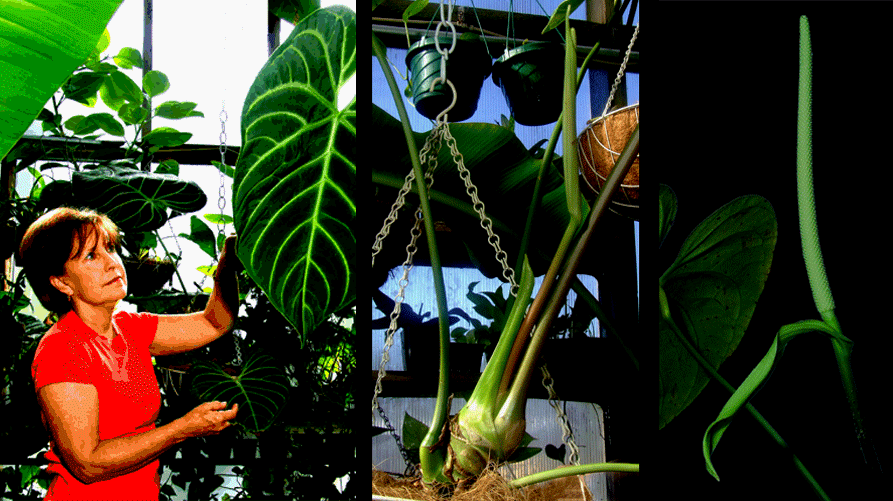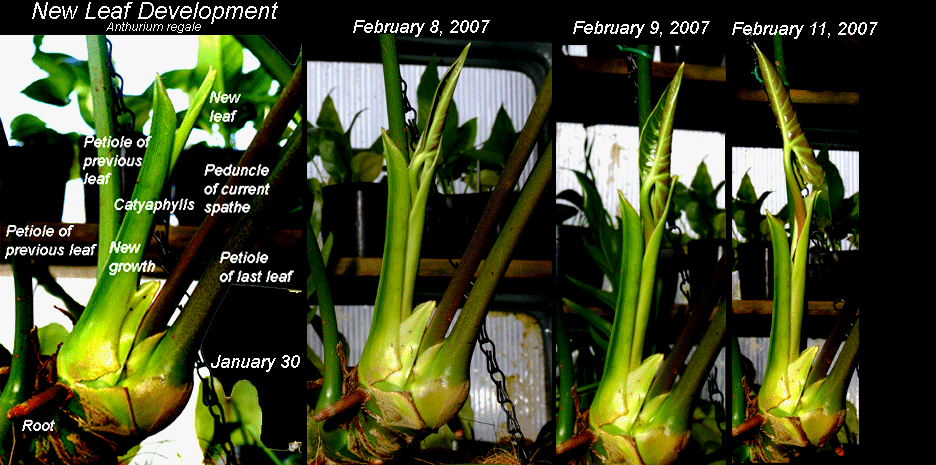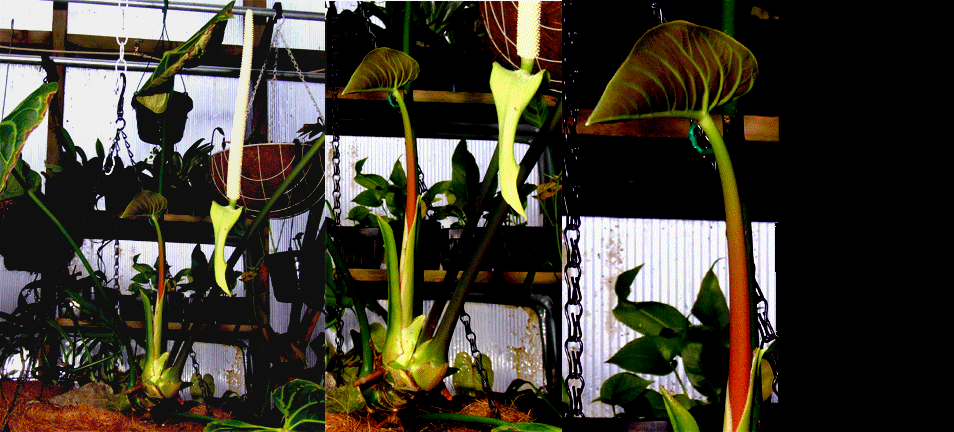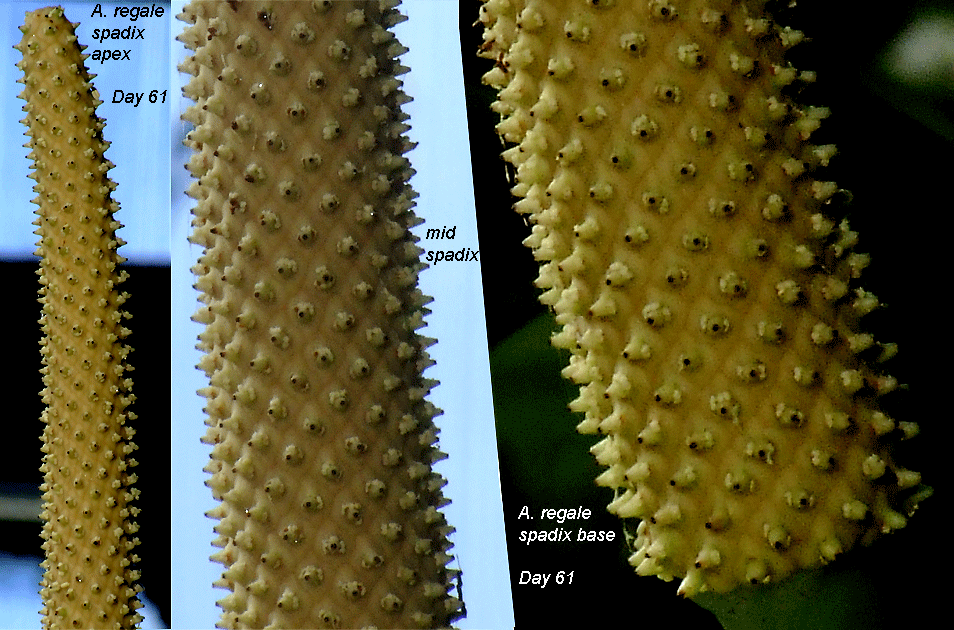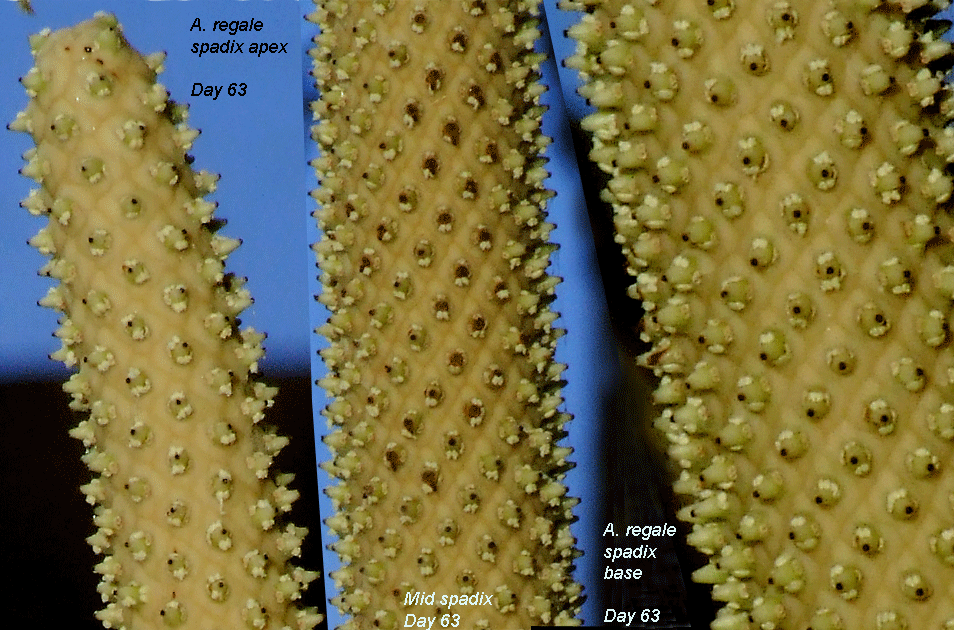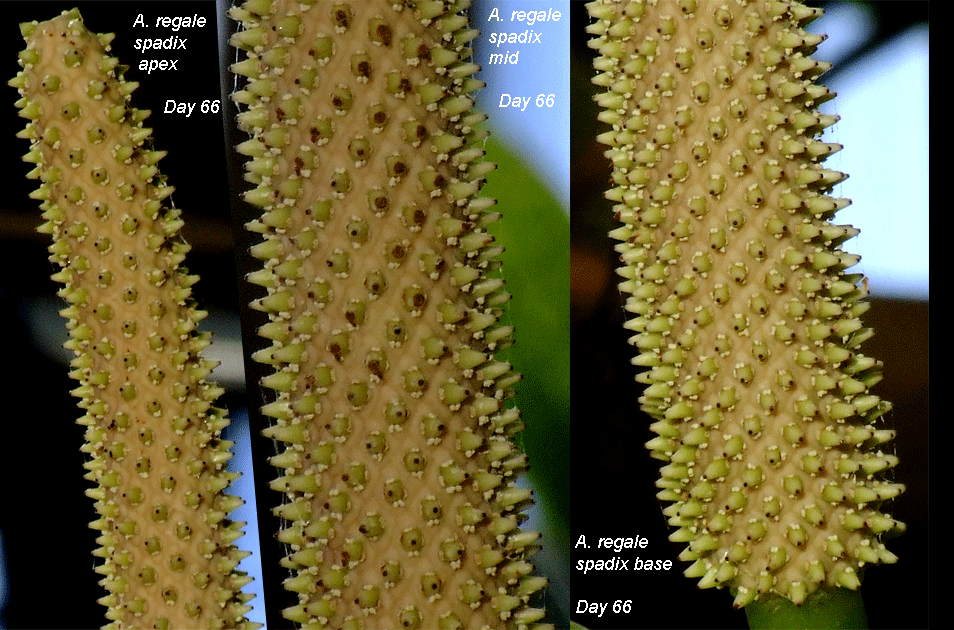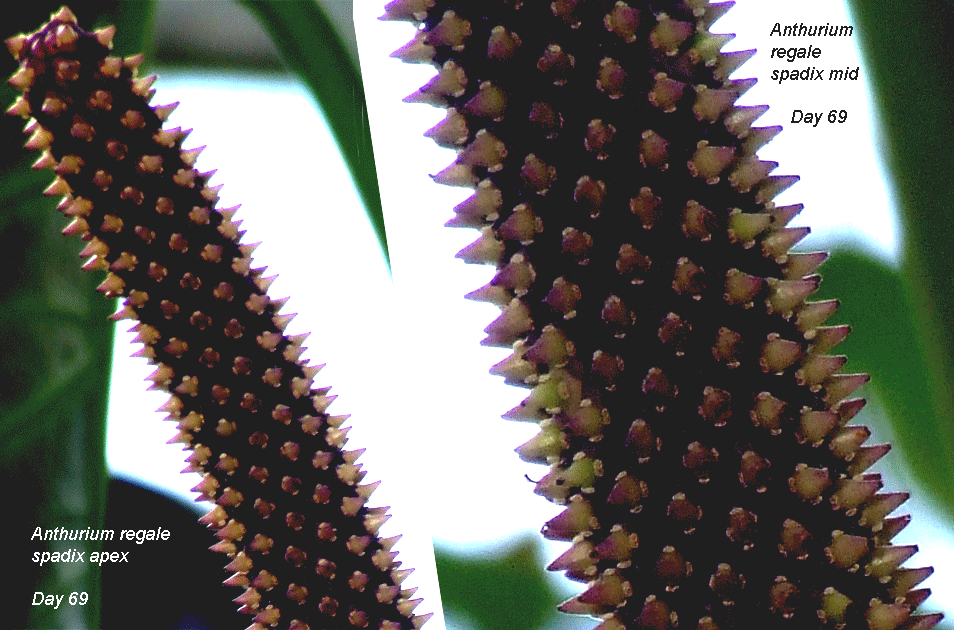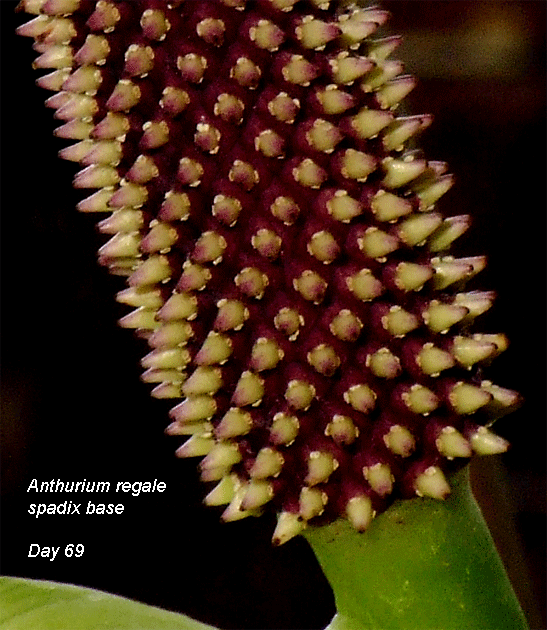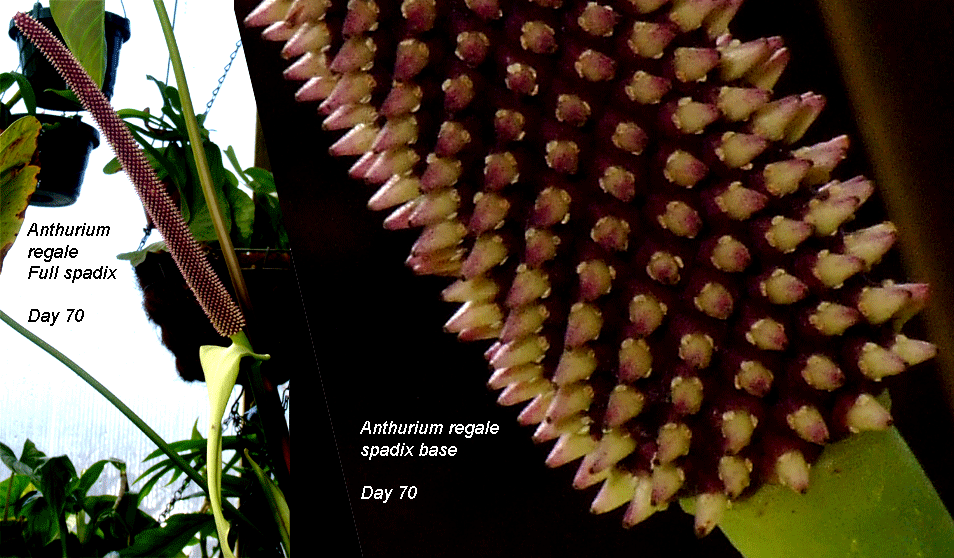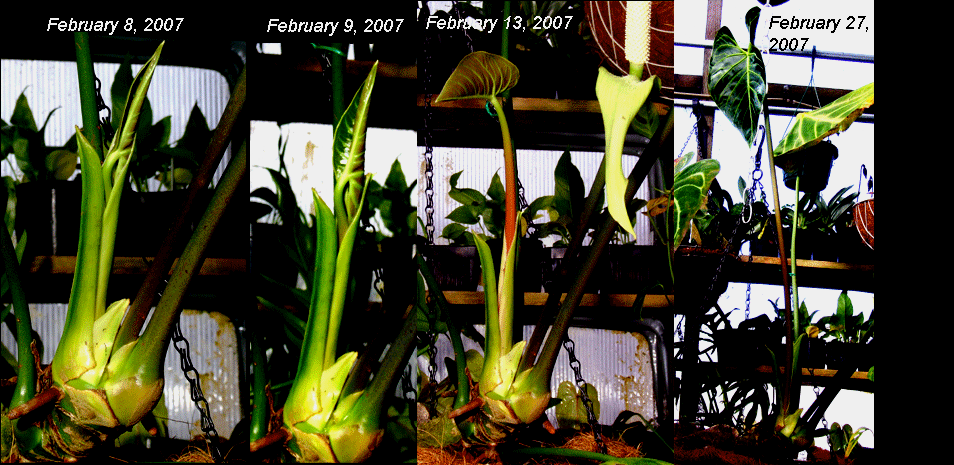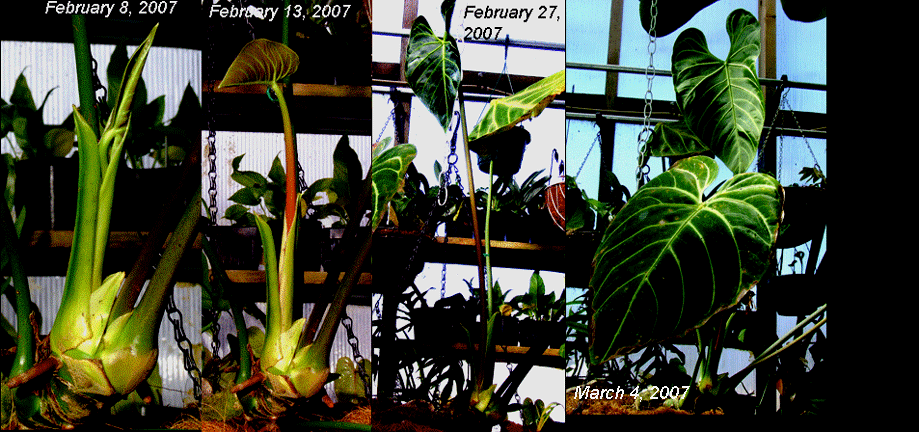The
new leaf is beginning to grow quickly. In 12 days it has
extended to 22 1/2cm (8 3/4 inches) and is now completely
visible above the cataphylls. The new leaf blade is
approximately 11.5cm long (4 3/8 inch) and will soon unfurl.
Day
56: WE HAVE STAMENS AND POLLEN!
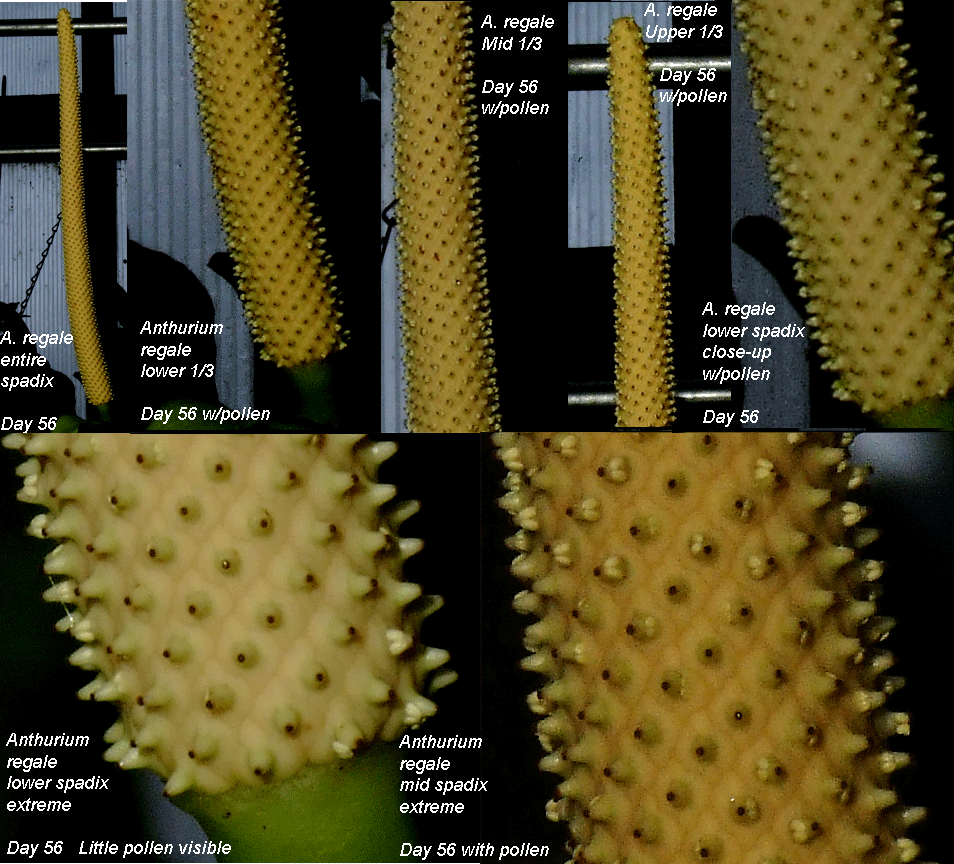
Day
56: For 56 days I have gazed at this spathe and spadix daily hoping to
see stamens and pollen. Today I almost missed them, this one almost fooled me. I fully expected the stamens and pollen to begin at the bottom and work
their way slowly up the spadix, they didn't. If
you look at the Day 56 lower spadix extreme photo (second row,
first image) you'll see very little evidence of stamens and/or pollen. I've stared at this
spot so long I was about to give up. But while making my
daily inspection, and testing for a fragrance, I noticed what
appeared to be powder.
Not only on the lower portion, but all over the entire spadix to
the apex!
The second extreme photo is approximately the mid section of the
spadix and far more activity is visible in the center than at the
bottom. As you continue up the length toward the apex you can see the
anticipated stamens all the way to the top. The last image
was taken approximately half way up the spadix in the mid
portion. My
best guess is the enlargement is approximately 15X lifesize and is the
maximum I dare enlarge the image lest it falls apart!
Today
we again have heavy overcast skies and rain. For several
days the overcast conditions has appears to have impeded the
production and/or shortened the duration of the pharamones. The scent was
strongly evident by 10:45AM and by 11:00AM as strong as I have
witnessed since it was first noticed less than one week ago.
By 2:00PM it was again completely gone. The
pheromones
persisted approximately 3 hours, unfortunately there are no
beetles to be attracted.
Shortly after the photos were taken I began checking to see if
the pollen could be harvested so it can be frozen for use with a
future spadix. I then notified Dr. Croat, Julius, and LariAnn.
Both Julius and LariAnn were quick to respond. Julius
excitedly responded,
"FINALLY! From what I have seen
so far in the photos, not only do you have pollen, but the male
stamens are very obvious, exactly as is illustrated in the
photocopy I sent you out of TGOA, pg. 108, "B", where they are
drawn in A. regale sticking out of the sides from under the
'scales' of the perigones, four per flower! It obviously
is maturing from the top of the spadix downwards, as in the
'extreme' shot of the middle of the spadix, only two of the four
stamens have emerged so far, but nearer the top all four are out
and visible!
Julius then went on
to ask that I have Dr. Croat comment on this "reverse" stamen
process. I did!
LariAnn appeared equally excited about what the photographs seemed
to be indicating,
"Yep,
that's the real McCoy; you have anthers there. Pollen may
already be present (i.e. the anthers having opened) but I can
tell that many of the anthers are not yet open. This will
happen fast now, and you should have the brush and vials close
at hand to collect the pollen."
I had already
checked with a brush to see if pollen could actually be seen
when the bristles were run across the spadix. They could!
Now I'm grabbing for the material Julius sent almost 2 months
ago to sort out what I am observing.
Shortly after Julius and LariAnn made their comments Dr. Croat
forwarded this message,
"This
is one of those species that puts out its stamens quickly
throughout the entire length of the spadix, a feature typical to
other members of section Cardiolonchium like Anthurium ravenii
Croat & Baker. It is a fairly rare phenomenon because most
species present their pollen over a much longer period of time,
starting at the base and slowly working toward the apex. I
notice that only the lateral stamens have emerged, either 1 or 2
per flower. It would be nice to know if the 3rd
(anterior) and 4th (posterior) stamens emerge equally
as fast and also throughout the entire spadix. The laterals
invariably emerge first but sometimes the third and fourth
stamens are not emerging together. You will shortly have the
most detailed history of flowering behavior of a species of
Anthurium that has ever been recorded. You could, of course do
this sort of thing for all the species and publish a comparative
study of flowering behavior like that one I published, but by
concentrating on specific species in more detail than I did."
Later, Dr.
Croat added this comment regarding the unusual progression of
the stamens,
"The staminal progression is said to be basioscopic rather than
acroscopic in this case. It is rare but happens in some
Lasioideae, I believe. I also happens in Anthurium when
the spadix is obconic or thumb shaped."
I am
excited to have been able to help document something apparently not
previously observed regarding
Anthurium
regale!
I have already begun plans to follow the process on other
species, but we still have more to observe on this one.
Hopefully other growers will want to do the same.
New Leaf
Development, February 13, 2007
On
February 13, 2007 the new leaf petiole has extended to 23cm (9
inches) above the base opening of the catayaphylls. The
new leaf development can be seen in relationship to the spathe
and spadix in the first photo. The blade has not increased
substantially in size, is approximately 11.5cm (4.5 inches), and
has yet to completely unfurl after 15 days.
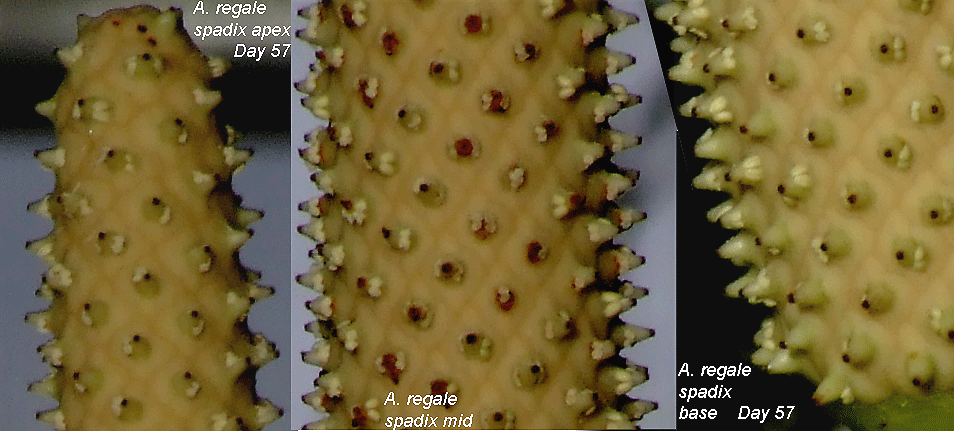
Day
57: At 11:15AM, 11:30AM, 12:00 noon and 12:15PM no noticeable scent
could be detected. It was 12:30PM before any could be
noticed and 1:00PM before it again became strong. By
2:30PM the scent was no longer evident. I have
elected to give the total photo space available today to extreme
enlargements of the apex, mid-section and base of the spadix.
Far more stamens are visible at the base. However, the
additional stamen pairs (anterior and posterior) Dr. Croat
anticipates will develop soon have not yet emerged. Julius explains with an
illustration that describes each tiny flower like the face of a
clock,
"IIonly
see stamens (two/paired) which have emerged from under the two
horizontal scales of the perigones. To better explain, I
see a total of four perigonal scales per flower, they are at
12, 3, 6 and 9 o`clock. The paired stamens have emerged only
from under two of the perigonal scales, those at 3 and 9 o`clock,
those at 12 and 6 o`clock are not visible as yet."
But then I
examined the apex photo again I wondered. Look at some of
the perigone's 12 o'clock and 6 o'clock positions. We will continue
to observe. Dr, Croat again commented,
"It looks to me like there are a few other stamens out but I am
not sure. I thought I saw one flower with one of the third
stamen out and another with the 4th stamen out. I am
not certain though because those were not in full focus and I
may have just been seeing the sides of one of the lateral
stamens. It would be surprising to see just the odd 3rd
or 4th stamen out without any perceived ."
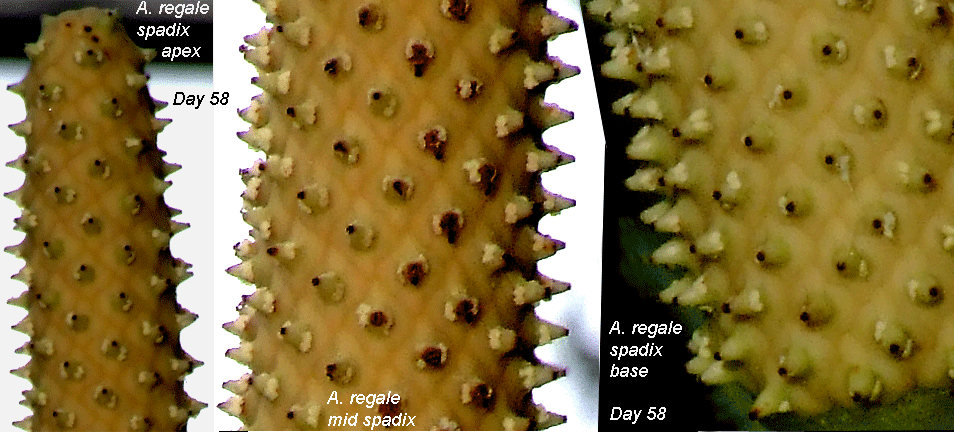
Day
58: Today the day began sunny but shortly turned heavily
overcast with blowing snow. Despite checking frequently
between 11:00AM and 2:00PM no scent could be ever be detected.
However, it appeared to me the anterior stamens may have begun to
appear on several perigones in the mid spadix photograph.
It also appeared I could see them on at least one perigone the posterior stamens
are just beginning to emerge. But my eyes don't have the
training of Dr. Croat's eyes! He soon pointed out, "I
seen no evidence you have any of the 3 or 4 sets out yet. They
will be obvious when they begin. Just keep track of the number
of days of delay between the laterals and the alternates. You
may even get a delay between the 3rd and 4th
sets."
Just a
note about the photographs. Please forgive these and other
images are not tack sharp. I have to deal with glaucoma in
both eyes and as a result must rely on the autofocus function of
the camera. I have yet to find a camera with perfect
autofocus, especially for close focus situations. The
extreme magnification also makes it difficult to capture
perfectly focused images as does the limited depth of field of
the camera lens at extreme enlargements. Hopefully we can
still observe the important factors. Please keep in mind
the actual spadix is only 1.5cm (5/8) inch wide!
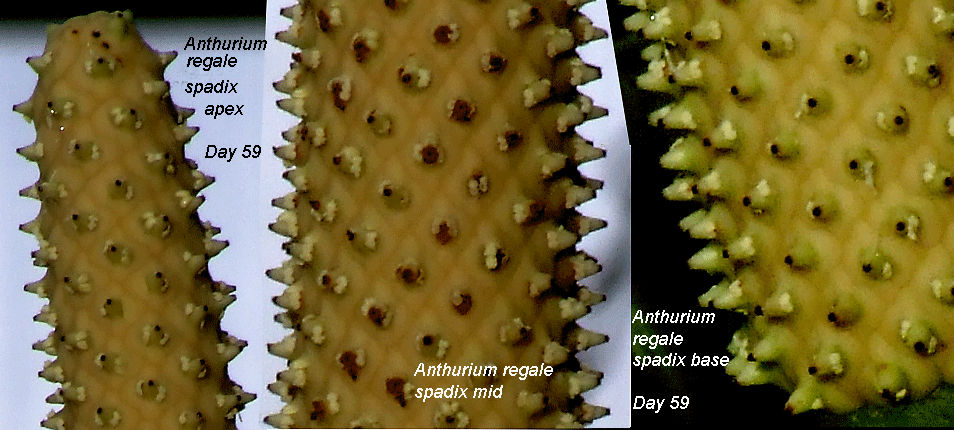
Day 59: It
is again extremely overcast today. We had snow part of the
night, however, don't think A. regale will tolerate the
cold! It is warm in the atrium. The scent did not
become evident until almost 1:00PM and by 1:30PM was quite
strong. Yesterday there were no discernable
pheromones at
any time during the day. My eyes may be deceiving me but I
believe I can see a few stamens in the 12 o'clock position on
some perigones as described earlier by Julius. But I will
wait for Dr. Croat's more experienced eyes to make the final
determination. The base of the spadix again appears to be
turning slightly green.
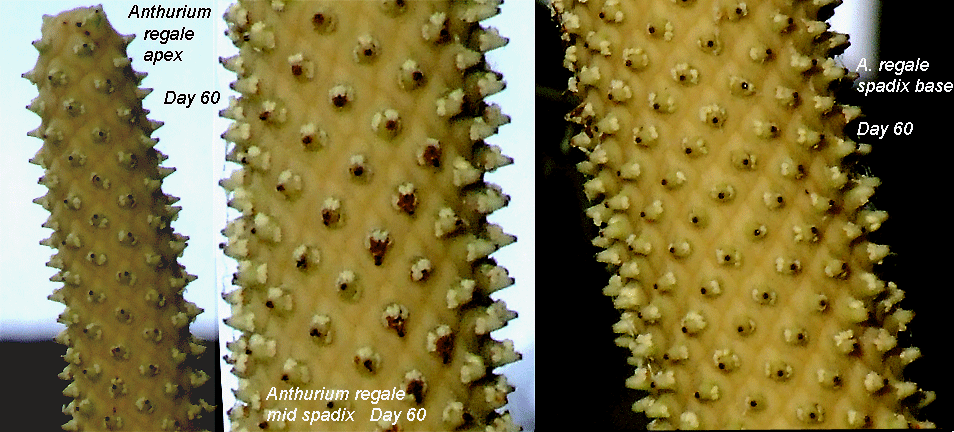
Day
60: Today we have bright sunshine after more than a week
of dreary overcast skies. I had hoped to learn if the
bright light could possibly affect or increase production of
pheromones.
Early in this event the daily scent lasted approximately 3
hours. Two days ago it could not be noticed.
Yesterday the duration was short, perhaps one hour, and today it
again was extremely faint. I am uncertain if the sun has
little affect or the process is nearing its end.
Regardless, it appears more stamens are present, especially the
anterior stamens on the center photograph. But I will
yield to Dr. Croat's opinion on what can actually be seen.
Strings of pollen appear to be visible at numerous places.
After reviewing
today's photographs Julius had these comments,
"This
really is all new to me, the actual sequence in which the
stamens are emerging! Yes, several anterior stamens are
clearly visible, and I saw a combination of at least one
anterior and a left lateral in one of the photos. I have no
idea on the 'why' of this sequence on emergence!"
All I
can say is, neither do I. Dr. Croat then responded,
"You are certainly right. Now, do they extend throughout the
spadix like the laterals did? Now try to figure out how much
delay there is before the 4th stamens (posterior)
come out."
It appears some anterior stamens can be observed in the lower
base section (right photo) but they do not extend throughout the
spadix thus far. Obviously, there is much more to learn
regarding this species. But I'm trying to learn
what I can every day!
Day
61: I wanted to allow you to see more of the spadix in a
magnified form. The only solution was to make the photo
panel as close as possible to the full size of the computer
screen. You are seeing almost of the entire spadix.
The day is bright and sunny and it appears the spadix is
reacting to the additional sunlight. Yesterday the scent
could barely be detected but today the
pheromones
appeared at 10:30AM and persisted until approximately 2:00PM.
We again had approximately 3 hours of pollinator attractant
available. It appears both the anterior and posterior
stamens are visible on the spadix apex. One place on the
mid photo appears to show the first stages of posterior stamen.
The anterior stamens are visible on a substantial number of the
base perigones, but I cannot find a trace of the posterior
stamens nearer the base. It appears the "delay time" Dr.
Croat asked about may be only a 24 hour period for at least
portions of the spadix but it appears it can be established the
pattern of emergence is lateral followed by anterior stamens
with the posterior stamens emerging last.
I have
been trying to learn about the production of anthers for this
species during this process. Today Dr. Croat offered this
explanation, "There
are always 4 stamens in each bisexual flower, one on each of the
four sides. Usually the lateral stamens emerge first, then the
anterior stamen, later the 4th or posterior stamen. The
filament is essentially flattened but often emerges quite fleshy
and the anther may
be initially pushed out beyond the end of the tepals but usually
quickly withdraws to the level of the tepals. The Anthers
consist of two thecae and split longitudinally."
Pollen is
clearly visible so we began the effort to collect as much as
possible. Janice did the work since her eyes are far
better than mine. Even though she worked slowly
using a very fine brush she felt more pollen was flying away
than was being transferred to the collecting tube using a very
small funnel. At the end we had collected a small amount
of very fine pollen dust and placed it safely in the
refrigerator. The tubes, provided by LariAnn Garner,
contained moisture absorbing material to keep the pollen as dry
as possible. Once the collection is completed in the next
week the collected pollen will be frozen for future use on
another spadix with a portion sent to LariAnn.
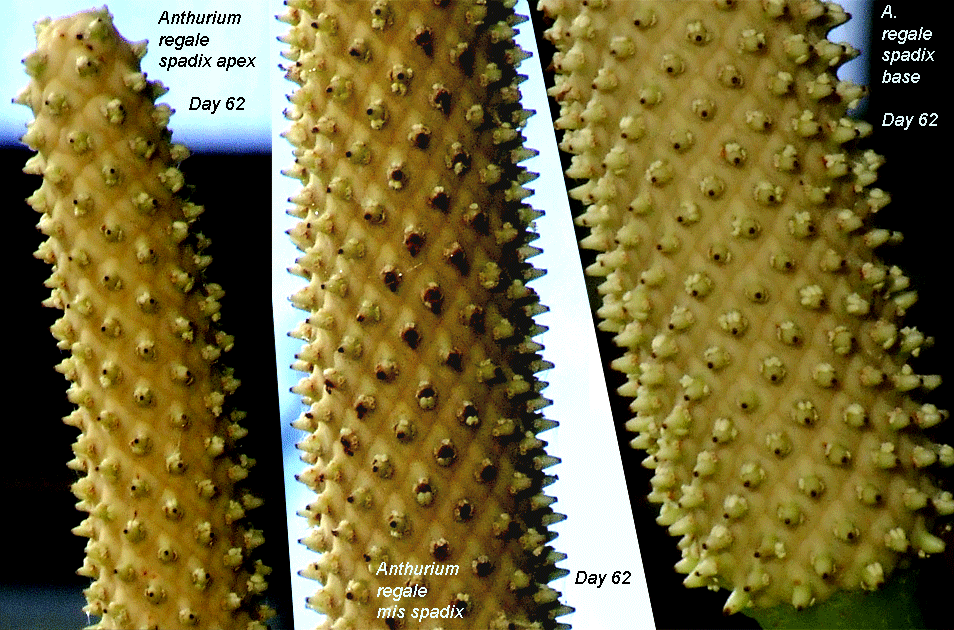
Day
62: Today the sun has been bright all day. I
expected the
pheromones to be
more intense but again I was surprised! The scent became
apparent shortly after 11:00AM but never became intense.
By 2:00PM it had again vanished. The duration was
approximately the same length, but the intensity appeared
decreased. Lateral, posterior and anterior stamens can be
seen on all three sections of the spadix but are not fully
extended on any. The posterior stamens are more visible
near the right edge of the base section (right photo) and are as
frequent on the mid section as the apex. None appear to be
in full extension. I find it interesting that on at least
one perigone on the far right photograph in the lower right
corner there appears to be only posterior stamens visible.
Neither lateral nor anterior stamens appear to be extended on
that perigone. Although some pollen can be observed, there
is less visible since we harvested all possible yesterday.
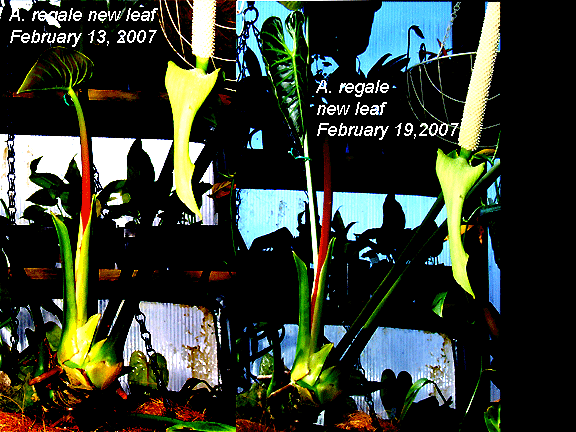
On
February 19, the new leaf has extended to 35cm (13 3/4 inches)
above the base of the catayaphylls. Today it was fully
unfurled for the first time. The blade now measures 14.5cm
(5 3/4 inches) in length. In 6 days the petiole has
extended an additional 23cm (9 inches).
Day
63: Again, the day is bright and sunny. The
pheromones were
faintly evident by 11:30AM and had again vanished by 1:30PM.
At no time during the 2 hour period was the scent strong.
On the apex of the spadix more anterior and posterior stamens are
now evident than lateral stamens. Although some lateral
stamens are evident on the mid section, the anterior and lateral
stamens appear to be more common. Near the base more
lateral, anterior and posterior stamens are evident, however some perigones appear to present only anterior and posterior stamens.
In very few places are lateral, anterior and posterior stamens
visible.
Julius and I have
commented about the slow rate of progress of the spadix
development. Today he commented,
"It
certainly is taking its time to get through its cycle! It will
be interesting to see how long the leaf blade takes to develop
to its full
size, and at what point the next bloom begins to emerge from the
sheath at this new leafs base!"
Sure will Julius.
Sure will!
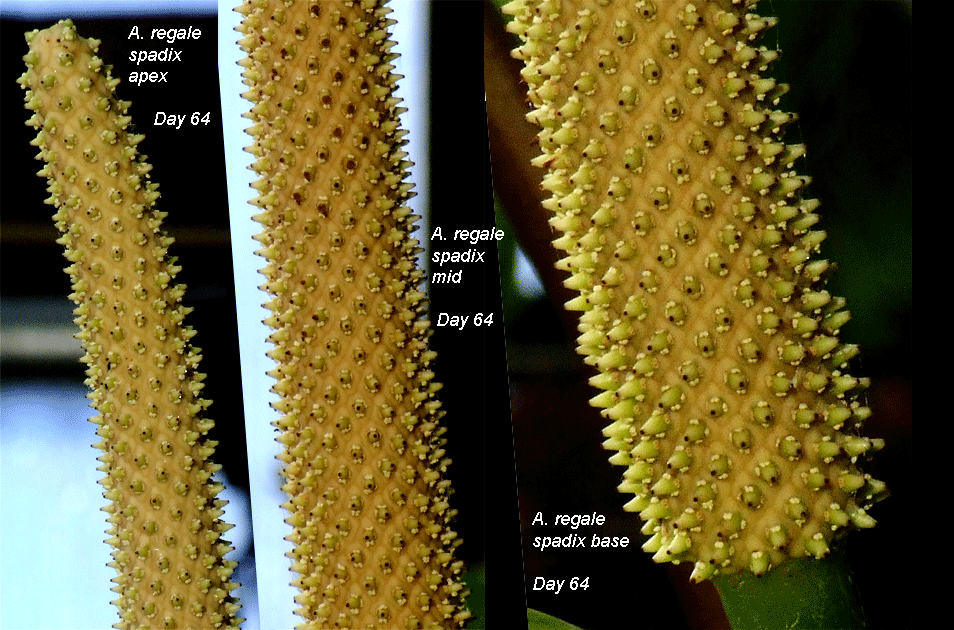
Day
64: Today is again bright and sunny, however, the scent was
again quite subdued. It did not become apparent until
after 12:00 noon. The duration appears to be shorter each
day and the
pheromones were
again gone sometime between 1:00PM and 1:30PM. I checked
the rigidity of the spadix and it appears to still be quite
rigid. Both anterior and posterior stamens are apparent
all over the spadix and appear equally evident on all sections.
Lateral stamens appear less evident near the apex but are still
very evident in the mid section. Over the entire spadix
both anterior, posterior and lateral stamens are most evident
nearer the base. We have not collected pollen for 2 days
but little appears to be apparent.
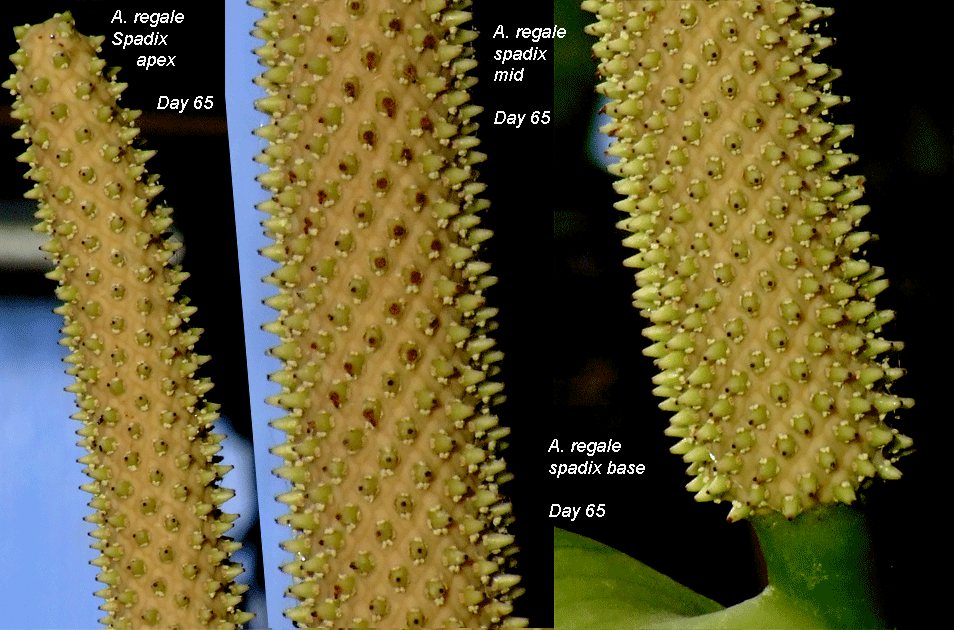
Day
65: Today is again bright with sun. At no time were the
pheromones
evident. It appears lateral, anterior and posterior
stamens are approximately equal in evidence on all sections of
the spadix. Pollen is not readily visible on any section,
however with a magnifying glass "strings" can still be seen near
the apex.
Day
66: Today it is still bright and sunny. Both day and night
temperatures in the atrium have risen dramatically and as a
result the humidity is near 95%. At no time could a scent
be detected, at least by my human nose! But look at the
spadix. Pollen is more evident today than in the past
several days. Strings can be seen on all three segments.
Lateral, anterior, and posterior stamens can be observed on all
sections as well but appear more obvious on the mid and base
sections. The question comes to mind, it the spadix is
producing more pollen, what attracts are being used?
Day 67
and Day 68: Due to one of my grandchildren's birthday
party in a city some hours away there won't be a photo on either
Day 67 and 68. I will resume the photos on Sunday,
February, 25.
Day
69: Upon our return it appears the spadix has dramatically
changed. Between Day 67 and 68 the entirety turned from
near ivory to purple. Near the apex the perigones have also
begun to change color as well. Lateral, anterior, and
posterior stamens still appear to be visible but absolutely no
pollen can be observed. Obviously, the reproduction cycle
has reached a climax.
Day
70: The entire reproduction process has come near the end.
All that remains to be seen is if the spadix has, by any strange
chance, been pollinated. If so, berries will begin to
form. If not, the entire inflorescence will soon drop from
the plant. Regardless, the sudden change in color has been
dramatic to observe. All the stamens appear to be
shrinking away.
In
just over four weeks of growth, the new leaf petiole has extended to 58.5cm (23 inches) and the
leaf blade is now approximately 23cm in length (9 inches).
The new leaf is showing the extreme velvet appearance common to
the species.
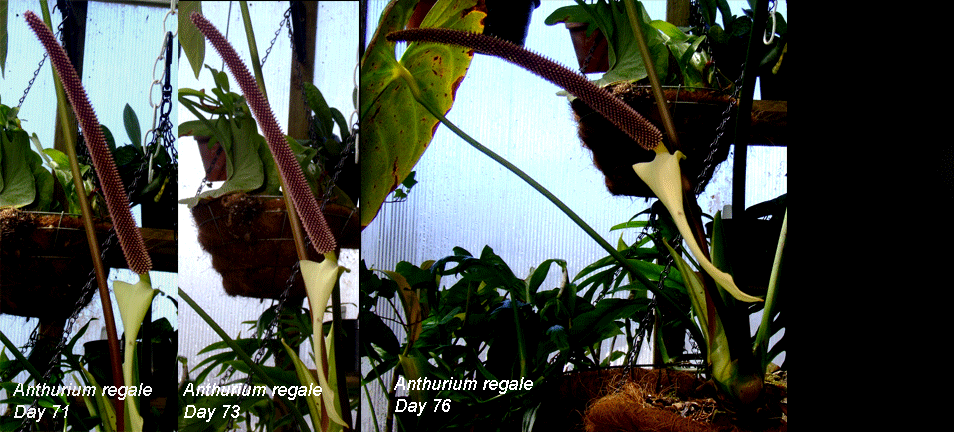
Day
71 to Day 78: No noticeable changed in the spadix from Day 70 to Day
71. The spadix may be slightly less rigid than one week
earlier. One grower informed me the seed berries, should
they form, should also be purple but it appears unlikely
berries will form in the absence of pre-collected pollen.
Between Day 71 and Day 73 the spadix appears to have bent just
slightly, yet no difference in rigidity can be detected. I
have been examining the apex closely with a good magnifying glass but there is no evidence of seed berry development.
With the absence of pollinators none is expected. Dr.
Croat made this comment earlier on Day 73,
"I would be surprised if your spadix produces seeds without
being pollinated but sometimes old collections never pollinated
do surprisingly set fruit, though they are usually sterile."
And as
usual, Tom is quite right. By Day 76 the spadix has lost a
considerable amount of rigidity and is beginning to lay
downwards. The spadix itself is now very flexible.
It appears it is now just a matter of days until it falls from
the plant. The purple color has noticeable dulled.
And on Day 78 the spadix fell from the plant thus ending the
cycle of the spathe and spadix.
By
March 4, 2207 the new leaf petiole has extended to over 60cm (24 inches)
and the blade has dramatically enlarged from the previous
measured size of 23cm (9 inches) to 36cm (14 inches). The
leaf beneath it was previously the second largest. The new
leaf has grown almost 13cm (5 inches) in just over one week! The
largest leaf is out of sight to the right. The new blade
is still a juvenile but has made incredible growth in just over
one month!
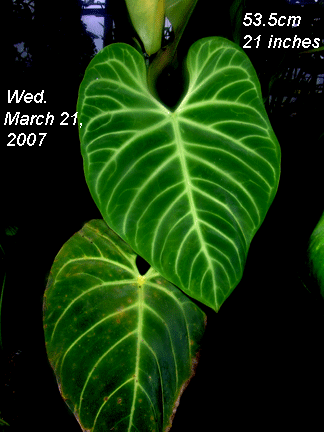
After
51 days of growth the new leaf has now reached a blade length of
53.5cm (21 inches). Measured again in mid April, that has
turned out to be the maximum size of the new blade, a full 20cm
(8 inches) short of the size of the previous blade. The petiole has extended to 71cm
(almost 28 inches). The largest previous 73cm (almost 29
inches) leaf is not visible. In the past 17 days the new
blade has grown 16.5cm (10 1/4 inches). The leaf shown
beneath the new blade was produced just before the previous
larger leaf. During the past 17 days it has grown at
a rate of approximately 1cm per day!
An
interesting observation was observed on April 17, 2007.
Normally in anthurium species a new leaf blade is followed by a
new spathe and spadix. In the case of this plant, the
specimen is now producing another new leaf.
![]()
